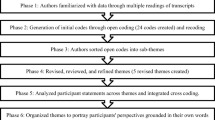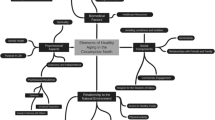Abstract
The purpose of the study was to elicit the definitions of successful aging according to Chinese and Hmong elders living in Milwaukee, WI. In-depth semi-structured interviews were conducted with 44 elders (Hmong n = 21 and Chinese n = 23). Findings show some similarities in the Chinese and Hmong elders’ definitions though specific cultural differences exist. Chinese elders emphasized physical health and mobility, mental health, positive attitudes, shedding responsibilities, positive family relationships, financial stability, social engagement, religious faith, and accomplishments and volunteer work. Hmong elders emphasized physical health and mobility, mental health, harmonious relationships, positive family relationships, tangible family support, financial stability, social engagement, and religious faith. Cross-cultural comparisons of the findings highlight the cultural heterogeneity between these two subgroups. Implications for practice are discussed.
Similar content being viewed by others
References
Bai, X., Wu, C., Zheng, R., & Ren, X. (2011). The psychometric evaluation of the Satisfaction with Life Scale using a nationally representative sample of China. Journal of Happiness Studies, 12, 183–197.
Bowling, A., & Dieppe, P. (2005). What is successful ageing and who should define it? BMJ, 331(7531), 1548–1551. doi:10.1136/bmj.331.7531.1548.
Bowling, A., & Iliffe, S. (2006). Which model of successful ageing should be used? Baseline findings from a British longitudinal survey of ageing. Age and Ageing, 35(6), 607–614. doi:10.1093/ageing/afl100.
Callahan, C. M., Unverzagt, F. W., Hui, S. L., Perkins, A. J., & Hendrie, H. C. (2002). Six-item screener to identify cognitive impairment among potential subjects for clinical research. Medical Care, 40(9), 771–781. doi:10.1097/01.MLR.0000024610.33213.C8.
Chen, M. R., Guo, Q. H., Cao, X. Y., Hong, Z., & Liu, X. H. (2010). A preliminary study of the six-item screener in detecting cognitive impairment. Neuroscience Bulletin, 26(4), 317–321. doi:10.1007/s12264-010-0106-1.
Cho, J., Martin, P., & Poon, L. W. (2012). The older they are, the less successful they become? Findings from the Georgia centenarian study. Journal of Aging Research, 2012, 695854. doi:10.1155/2012/695854.
Corbin, J., & Strauss, A. (1990). Grounded theory method: procedures, canons, and evaluative criteria. Qualitative Sociology, 13, 3–21.
Diener, E., Emmons, R. A., Larsen, R. J., & Griffin, S. (1985). The satisfaction with life scale. Journal of Personality Assessment, 49(1), 71–75. doi:10.1207/s15327752jpa4901_13.
Dillaway, H. E., & Byrnes, M. (2009). Reconsidering successful aging: a call for renewed and expanded academic critiques and conceptualizations. Journal of Applied Gerontology, 28(6), 702–722.
Dossa, P. A. (1999). (Re)imagining aging lives: ethnographic narratives of Muslim women in diaspora. Journal of Cross-Cultural Gerontology, 14(3), 245–272.
Hale, W. D., & Bennett, R. G. (2003). Addressing health needs of an aging society through medical-religious partnerships: what do clergy and laity think? Gerontologist, 43(6), 925–930.
Iwamasa, G. Y., & Iwasaki, M. (2011). A new multidimensional model of successful aging: perceptions of Japanese American older adults. Journal of Cross-Cultural Gerontology, 26(3), 261–278. doi:10.1007/s10823-011-9147-9.
Kaufman, S. R. (1986). The ageless self. Madison: The University of Wisconsin Press.
Leung, B. W., Moneta, G. B., & McBride-Chang, C. (2005). Think positively and feel positively: optimism and life satisfaction in late life. International Journal of Aging and Human Development, 61(4), 335–365.
Lewis, J. P. (2010). Successful aging through the eyes of Alaska Natives: exploring generational differences among Alaska Natives. Journal of Cross-Cultural Gerontology, 25(4), 385–396. doi:10.1007/s10823-010-9124-8.
Li, C., Wu, W., Jin, H., Zhang, X., Xue, H., He, Y., . . . Zhang, M. (2006). Successful aging in Shanghai, China: definition, distribution and related factors. International Psychogeriatrics, 18(3), 551–563. doi:10.1017/S1041610205002966.
Li, L. W., Long, Y., Essex, E. L., Sui, Y., & Gao, L. (2012). Elderly Chinese and their family caregivers’ perceptions of good care: a qualitative study in Shandong, China. Journal of Gerontological Social Work, 55(7), 609–625. doi:10.1080/01634372.2012.703165.
Lynch, J., & Kaplan, G. (2000). Socioeconomic position. In L. Berkman & I. Kawachi (Eds.), Social epidemiology. New York: Oxford University Press.
Marmot, M., Ryff, C. D., Bumpass, L. L., Shipley, M., & Marks, N. F. (1997). Social inequalities in health: next questions and converging evidence. Social Science and Medicine, 44(6), 901–910.
Matsubayashi, K., Ishine, M., Wada, T., & Okumiya, K. (2006). Older adults’ views of “successful aging”: comparison of older Japanese and Americans. Journal of the American Geriatrics Society, 54(1), 184–187. doi:10.1111/j.1532-5415.2005.00575_15.x.
McCann Mortimer, P., Ward, L., & Winefield, H. (2008). Successful ageing by whose definition? Views of older, spiritually affiliated women. Australasian Journal on Ageing, 27(4), 200–204. doi:10.1111/j.1741-6612.2008.00305.x.
Mjelde-Mossey, L. A., Chin, I., Lubben, J., & Lou, V. W. Q. (2009). Relationship between productive activities, family relations, and aging well for elders in China. Journal of Ethnic and Cultural Diversity in Social Work, 18, 276–292.
Moore, K. L. (2010). Sexuality and sense of self in later life: Japanese men’s and women’s reflections on sex and aging. Journal of Cross-Cultural Gerontology, 25(2), 149–163. doi:10.1007/s10823-010-9115-9.
Morse, J. M. (1994). Designing funded qualitative research. In N. K. Denzin & Y. S. Lincoln (Eds.), Handbook of qualitative research (pp. 220–235). Thousand Oaks: Sage.
Ng, T. P., Broekman, B. F., Niti, M., Gwee, X., & Kua, E. H. (2009). Determinants of successful aging using a multidimensional definition among Chinese elderly in Singapore. The American Journal of Geriatric Psychiatry, 17(5), 407–416. doi:10.1097/JGP.0b013e31819a808e.
Ng, S. H., Cheung, C. K., Chong, A. M., Woo, J., Kwan, A. Y., & Lai, S. (2011). Aging well socially through engagement with life: adapting Rowe and Kahn’s model of successful aging to Chinese cultural context. International Journal of Aging and Human Development, 73(4), 313–330.
Pang, E. C., Jordan-Marsh, M., Silverstein, M., & Cody, M. (2003). Health-seeking behaviors of elderly Chinese Americans: shifts in expectations. Gerontologist, 43(6), 864–874.
Patel, K. K., Frausto, K. A., Staunton, A. D., Souffront, J., & Derose, K. P. (2013). Exploring community health center and faith-based partnerships: community residents’ perspectives. Journal of Health Care for the Poor and Underserved, 24(1), 262–274. doi:10.1353/hpu.2013.0016.
Patton, M. Q. (2002). Qualitative research and evaluation methods. Thousand Oaks: Sage Publications.
Pavot, W., Diener, E., Colvin, C. R., & Sandvik, E. (1991). Further validation of the Satisfaction with Life Scale: evidence for the cross-method convergence of well-being measures. Journal of Personality Assessment, 57(1), 149–161. doi:10.1207/s15327752jpa5701_17.
Pfeifer, M. E., Sullivan, K. Y., Yang, K., & Yang, W. (2012). Hmong population and demographic trends in the 2010 Census and 2010 American Community Survey. Hmong Studies Journal, 13(2), 1–31.
Phelan, E. A., & Larson, E. B. (2002). “Successful aging”–where next? Journal of the American Geriatrics Society, 50(7), 1306–1308.
Phelan, E. A., Anderson, L. A., LaCroix, A. Z., & Larson, E. B. (2004). Older adults’ views of “successful aging”–how do they compare with researchers’ definitions? Journal of the American Geriatrics Society, 52(2), 211–216.
Phinney, J. S., Ong, A., & Madden, T. (2000). Cultural values and intergenerational value discrepancies in immigrant and non-immigrant families. Child Development, 71(2), 528–539.
Pruchno, R. A., Wilson-Genderson, M., & Cartwright, F. (2010). A two-factor model of successful aging. Journals of Gerontology. Series B, Psychological Sciences and Social Sciences, 65(6), 671–679. doi:10.1093/geronb/gbq051.
Rowe, J. W., & Kahn, R. L. (1987). Human aging: usual and successful. Science, 237(4811), 143–149.
Scheidt, R. J., Humphreys, D. R., & Yorgason, J. B. (1999). Successful aging: what’s not to like? Journal of Applied Gerontology, 18(3), 277–282.
Strauss, A., & Corbin, J. (1994). Grounded theory methodology. In N. K. Denzin & Y. Lincoln (Eds.), Handbook of qualitative research (pp. 273–285). Thousand Oaks: Sage.
Tan, J., Ward, J., & Ziaian, T. (2010). Experiences of Chinese immigrants and Anglo-Australians ageing in Australia: a cross-cultural perspective. Journal of Health Psychology, 15, 697–706.
Terrill, L., & Gullifer, J. (2010). Growing older: a qualitative inquiry into the textured narratives of older, rural women. Journal of Health Psychology, 15(5), 707–715. doi:10.1177/1359105310368180.
Vahia, I. V., Thompson, W. K., Depp, C. A., Allison, M., & Jeste, D. V. (2011). Developing a dimensional model for successful cognitive and emotional aging. International Psychogeriatrics, 24, 1–9. doi:10.1017/S1041610211002055.
World Health Organization (2007). Global age-friendly cities: A guide. Geneva, Switzerland: WHO Press.
Zimmer, Z., & Lin, H. S. (1996). Leisure activity and well-being among the elderly in Taiwan: testing hypothesis in an Asian setting. Journal of Cross-Cultural Gerontology, 11(2), 167–186.
Acknowledgments
This project was supported in part by Grant Number F31AG039232 from the National Institute on Aging. Data presented in this manuscript were collected as part of the primary author’s doctoral dissertation in the Institute for Health and Society, Medical College of Wisconsin. The content is solely the responsibility of the authors and does not necessarily represent the official views of the National Institute on Aging or the National Institutes of Health.
Author information
Authors and Affiliations
Corresponding author
Rights and permissions
About this article
Cite this article
Nguyen, A.L., Seal, D.W. Cross-Cultural Comparison of Successful Aging Definitions Between Chinese and Hmong Elders in the United States. J Cross Cult Gerontol 29, 153–171 (2014). https://doi.org/10.1007/s10823-014-9231-z
Published:
Issue Date:
DOI: https://doi.org/10.1007/s10823-014-9231-z




